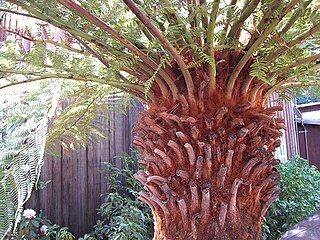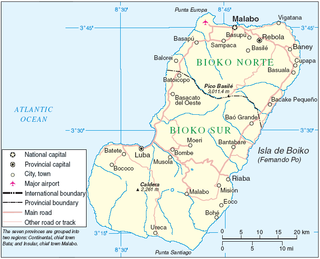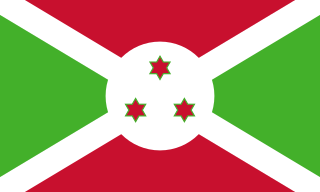Cnemidaria is a genus of small tree ferns in the family Cyatheaceae. They are subaborescent or marginally aborescent, growing as tall as 3.5 m with a trunk diameter of 7 cm.
Cyathea affinis is a variable species of tree fern native to Fiji, Samoa, the Cook Islands, Austral Islands, Tahiti, and the Marquesas Islands. The trunk of this plant is erect and 2–6 m tall. Fronds are bipinnate and 2–3 m in length. The rachis and stipe are pale to brown in colour, or flushed with red towards the pinnule rachis. The stipe is sparsely covered in narrow basal scales, which are pale to dark and have broad fragile edges. Characteristically of this species, the lowest one or two pairs of pinnae may be slightly reduced and occur towards the base of the stipe. Sori are located near the pinnule midvein and are partially or fully covered by indusia, which open towards the pinnule margin.
Cyathea archboldii is a species of tree fern native to New Guinea and Bougainville, where it is common in submontane rain forest at an altitude of 1000–3000 m. The trunk is erect and up to about 3 m tall. Fronds are bipinnate and 2–3 m long. The rachis may be purplish and has short spines and scales. The scales range in colour from pale to brown, to bicoloured and have fragile edges. Sori occur in two rows along each side of the pinnule midvein and are covered by firm indusia.
Cyathea atropurpurea is a species of tree fern native to the islands of Luzon, Mindanao, Leyte and Mindanao in the Philippines, where it grows in forest at above 1000 m. The erect trunk is slender and may be up to 3 m tall. Fronds are bipinnate and 1–2 m long. Characteristically of this species, the final pair of pinnae are usually reduced and occur towards the base of the stipe. These, along with the stipe bases, are persistent and retained around the trunk long after withering. The stipe itself is dark and covered with scales, which are either small, dull and brown or large, dark and glossy. Sori occur near the midvein of fertile pinnules and lack indusia. Fertile pinnules are notably smaller than sterile ones.
Cyathea baileyana, also known as the wig tree fern, is a species of tree fern native to northeastern Queensland in Australia, where it grows in wet gullies and forest at an altitude of 850–1200 m. It is a rare species that is seldom found in the wild. The erect trunk is 4–5 m tall, approximately 10 cm in diameter and may be covered in stipe bases in the upper regions. C. baileyana is notable for being able to develop offshoots from the base of the trunk. Fronds are bi- or tripinnate and may be exceptionally long, up to 7 m, though they are usually around 2–3 m. The rachis and stipe are dark to darkish red, scaly and may be warty, but lack spines. Scales on the rachis and stipe are purplish brown to black and have a long hair-like apex. Characteristically of this species, the last pair of pinnae are separated from the others along the rachis and may form a clump around the trunk apex. Sori are circular and occur in one to three rows along the pinnule midvein. They lack indusia.
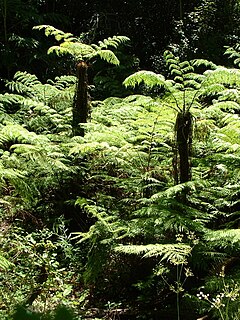
Cyathea capensis is a regionally widespread and highly variable species of tree fern. It is indigenous to Southern Africa and South America.
Cyathea catillifera is a species of tree fern native to eastern New Guinea, where it grows in montane scrub at an altitude of about 2800 m and above. It is a rare plant, known only from the type locality. The erect trunk is up to about 1 m tall and 10 cm in diameter. Characteristically of this species, the trunk often branches at the base. Fronds are bi- or tripinnate, 1–2 m long and may bear a pair of reduced pinnae towards the base. There are usually around six live fronds per crown at any one time. The stipe is spiny, warty and pale on the upper surface to dark at the base. It is |covered with scattered basal scales that are glossy dark brown and have a paler margin. Stipes are persistent with bases retained on the trunk. Sori occur near the midvein of fertile pinnules and are covered by thin, brown indusia that are saucer-like in appearance.

Cyathea dregei is a widespread species of tree fern in southern Africa.
Cyathea fenicis is a species of tree fern native to the Philippines, Taiwan, and Orchid Island, where it grows in wet forest, forest margins and on hillsides. The trunk is erect, up to 1 m tall and about 6 cm in diameter. Fronds are tripinnate and 1.5–2 m long. Characteristically of this species, the lowest pinnae are usually reduced. The stipe is spiny and ranges in colour from brown to purple-dark brown. It bears two types of scales: long dark brown scales as well as minute brown ones. Occasionally the scales are pale. Sori are round and arranged in two rows, one on either side of the pinnule midvein. They are covered by very small indusia that resemble scales in appearance.
Cyathea grevilleana is a species of tree fern endemic to Jamaica, where it grows in moist gullies and on wooded hills in both calcareous and noncalcareous soils at an altitude of 200–1200 m. The trunk of this plant is erect, about 7 m tall, and 10–15 cm in diameter. It is characteristically clothed in old stipe bases, brown scales and blackish spines. Fronds are tripinnate, dark green in colour, and up to 4 m in length. The last pinnae are sometimes separated, forming a distinctive clump around the trunk apex. The rachis is yellow-brown and almost smooth. This species has a long, dark brown stipe with a few scattered spines. Sori are produced in four to six pairs along the pinnule midvein. They are protected by pale brown indusia that are cup-like in appearance.
Cyathea hookeri is a species of tree fern endemic to Sri Lanka, where it grows in lowland forest. This plant has a narrow, erect trunk that is usually 1–2 m tall. Fronds are pinnate and approximately 1 m in length. The stipe is dark and covered with blunt spines and scattered scales. These scales are long, glossy, medium brown in colouration, and have fragile edges. Sori are borne on the lowest one or two pairs of veins of fertile pinnules. They are protected by thin indusia.
Cyathea hornei is a species of tree fern. Its natural distribution covers eastern New Guinea and the Louisiade Archipelago to Fiji, where it grows in wet submontane forest, stunted forest, mossy forest, and on ridges, at an altitude of 400–2000 m. The trunk of this plant is erect, 3–4 m tall and up to about 4 cm in diameter. Fronds may be pinnate or bipinnate and reach a length of 2 m. Basal scales cover the dark rachis and stipe of this species. These scales are glossy and either bicoloured or light brown and bullate. Sori almost cover the lower segments of fertile pinnules. Indusia are absent.
Cyathea imrayana is a species of tree fern native to Dominica, Costa Rica, Panama, Venezuela, and Ecuador.
Cyathea junghuhniana is a species of tree fern native to southern and central Sumatra and western Java, where it grows in forest at an altitude of 1000–2000 m. The trunk of this species is erect and may be 2 m tall or more. Fronds are tripinnate and up to about 3 m long. The stipes of this species are persistent and form a skirt around the trunk. They are brown, spiny, and covered with glossy, dark brown scales. Sori are borne near the midvein of fertile pinnules and are protected by thin indusia.
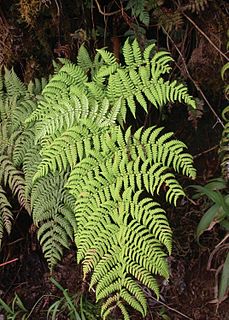
Dryopteris macropholis is a species of fern. It is distributed on the Marquesas Islands.
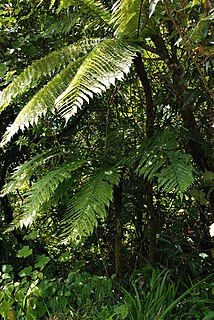
Cyathea borbonica is a tree fern endemic to Mauritius, Réunion and the islands of the south-western Indian Ocean. There are several natural forms and varieties.

Gleichenia polypodioides (L.) Sm., commonly known as coral fern, kystervaring or ystervaring due to its glabrous, brown, wiry stipes. The species is widespread in south- and east tropical Africa, southern Africa and the western Indian Ocean region. It occurs naturally in a broad coastal belt in South Africa, Lesotho, Swaziland, Angola, Malawi, Burundi, Tanzania, Mozambique, Zimbabwe, Mauritius, Réunion, Amsterdam Island and Madagascar, and was first described by Linnaeus in 1771 under the name Onoclea polypodioides. Often forming dense and impenetrable thickets, sometimes over large areas, this rhizomatous perennial is an important pioneer in disturbed areas such as pine plantations. It is often mistakenly seen as an exotic invader rather than as a useful rehabilitation plant, a source of peat and growing medium, while showing exceptional resistance to herbicides.
Rhizome brown, 1–2.5 mm. in diam., creeping, with long-spined dark-brown scales up to 0.5 mm. in diam., with fronds spaced 2–20 cm. apart. Stipe castaneous, up to 60 cm. long and up to 1.5 mm. in diam., glabrous or with a few scales similar to those on the rhizome, shallowly sulcate. Frond bifurcate to reniform-lunate in outline, with 1 level of false dichotomy in each lateral branch system arising from each side of the terminal bud; all branches bearing distant foliar segments. Aborted apical buds up to 1.2 mm. long, clothed in dark-brown lanceolate laciniate scales. Pinnules linear, up to 7 x 0.75 cm., pinnate, usually glabrous, divided into sessile rounded entire triangular lobes, 3 x 2 mm., green to glaucous below. Sori partially immersed in the lamina, consisting of 2–4 sporangia, each in a separate but adjoining pit.

Dryopteris inaequalis is an Afrotropical fern species that ranges from tropical and southern Africa to Madagascar. It has been recorded in Tanzania, Zambia, Malawi, Mozambique, Zimbabwe and South Africa, where it is present in the Western Cape, Eastern Cape and KwaZulu-Natal. It is found on forest floors and along forest margins, from middle to high altitudes.


